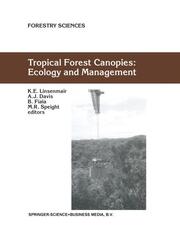-
Zusatztext
-
Almost half of all life on earth may exist in the world''s forest canopies. They may also play a vital role in maintaining the planet''s climate, yet they remain largely unexplored owing to difficulties of access. They are renowned for their great diversity and role in forest functioning, yet there are still great gaps in the understanding of this last biological frontier''. This seminal book shows how canopy science is now in a position to answer many of the outstanding questions, among which are some of the most pressing environmental issues society is presently facing. It represents a major summary of the current understanding of canopy ecology, and maps a path forward into a greater understanding of tropical forest ecology and management at a time when the very future of this ecosystem is threatened by humanity''s actions.
-
-
Autorenportrait
- InhaltsangabeForeword; K.E. Linsenmair. Introduction: Canopy Science: time to shape up; A. Mitchell. Section 1: Sampling and access. Alice grows up: canopy science in transition from Wonderland to Reality; S.L. Sutton. Forest canopy research: sampling problems, and some solutions; M.G. Barker, M.A. Pinard. Section 2: Plants in the canopy. Plants in the forest canopy: some reflections on current research and future direction; M.D. Lowman. Epiphytes and their contribution to canopy diversity; J. Nieder, et al. Plant size: an ignored parameter in epiphyte ecophysiology? G. Schmidt, et al. Pollination and phenology of flowers in the canopy of two contrasting rain forest types in Amazonia, Colombia; A. van Dulmen. Section 3: Animals in the canopy. Invertebrates in the canopy of tropical rain forests: how much do we really know; Y. Basset. Arboreal tropical forest vertebrates: current knowledge and research trends; R. Kays, A. Allison. Vertical stratification of figs and fig-eaters in a Bornean lowland rain forest: how is the canopy different? M. Shanahan, S.G. Compton. Understorey versus canopy: patterns of vertical stratification and diversity among Lepidoptera in a Bornean rain forest; C.H. Schulze, et al. The influence of anthropogenic disturbances on the structure of arboreal arthropod communities; A. Floren, K.E. Linsenmair. Seasonal changes in the canopy arthropod fauna in Rinorea beniensis in Budongo Forest, Uganda; T. Wagner. Arthropods in tropical oaks: differences in their spatial distributions within tree crowns; U. Simon, K.E. Linsenmair. Behaviour and ecology of birds in tropical rain forest canopies; H. Winkler, M. Preleuthner. Section 4: Hydrology, microclimate andlight. Canopy processes: implications for transpiration, interception and splash induced erosion, ultimately for forest management and water resources; I.R. Calder. Modelling rainfall and canopy controls on net-precipitation beneath selectively-logged tropical forest; N.A. Chappell, et al. Micrometeorological conditions and canopy energy exchanges of a neotropical rain forest (Suromoni-Crane Project, Venezuela); J. Szarzynski, D. Anhuf. The influence of epiphyte cover on branch temperature in a tropical tree; M. Freiberg. Forest light and its influence on habitat selection; M. Théry. Section 5: Architecture. Methods to assess tropical rain forest canopy structure: an overview; F. Bongers. Three architecture in a Bornean lowland rain forest: intra- and inter-specific patterns; F.J. Sterck, et al. Canopy surface topography in a French Guiana forest and the folded forest theory; P. Birnbaum. Crown typography and the identification of rain forest trees on large-scale aerial photographs; V. Trichon. Section 6: Education, management and conservation. The management implications of canopy research; N.E. Stork. Neotropical bats in the canopy: diversity, community structure, and implications for conservation; E.K.V. Kalko, C.O. Handley. Reproductive ecology of tropical forest trees in logged and fragmented habitats in Thailand and Costa Rica; J. Ghazoul, M. McLeish. Edge effects and tropical forest canopy invertebrates; A. Foggo, et al. Enhancement of forest canopy research, education, and conservation in the new millennium; N.M. Nadkarni. Index.
Detailansicht
Tropical Forest Canopies: Ecology and Management
Forestry Sciences, Volume 69, Forestry Sciences 69
ISBN/EAN: 9780792370499
Umbreit-Nr.: 1467351
Sprache:
Englisch
Umfang: vii, 370 S., 45 s/w Illustr., 370 p. 45 illus.
Format in cm:
Einband:
gebundenes Buch
Erschienen am 30.09.2001


